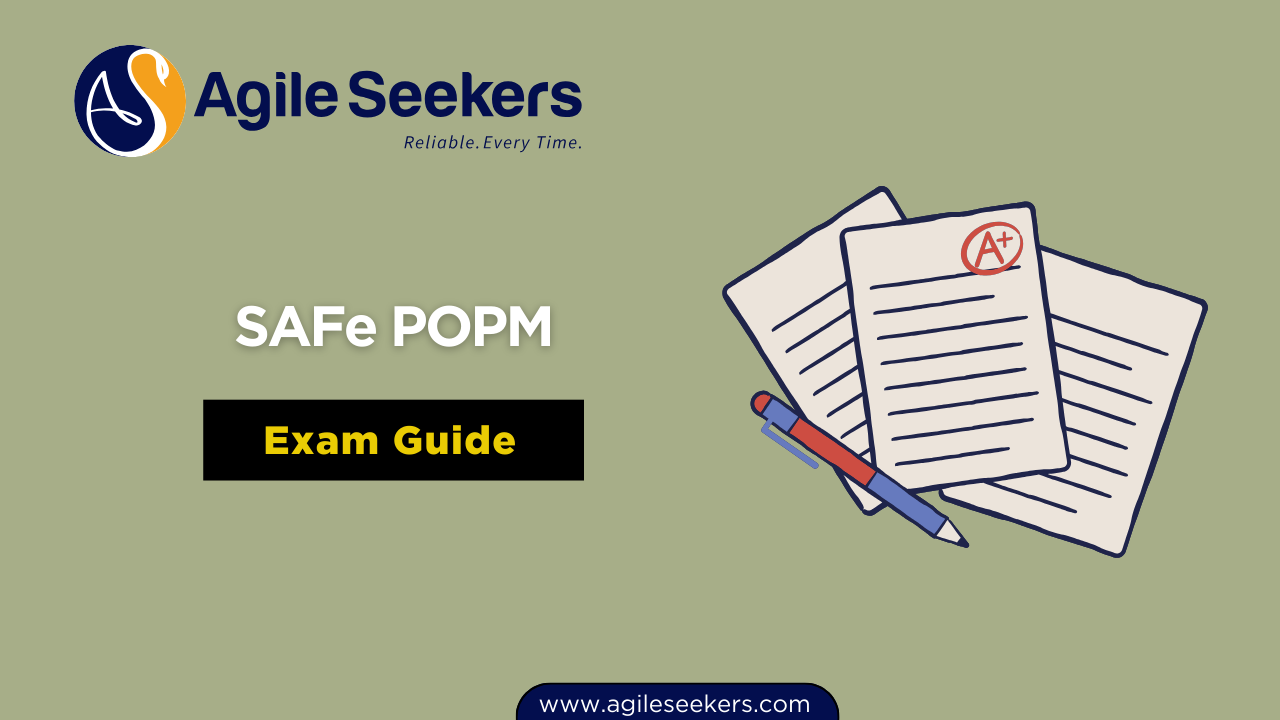How to Prepare for the SAFe POPM Exam in 2025

The SAFe Product Owner/Product Manager (POPM) certification has become a valuable credential for professionals managing products in agile organizations. As more enterprises adopt the Scaled Agile Framework (SAFe), the demand for certified Product Owners and Product Managers continues to grow. If you're planning to take the SAFe POPM exam in 2025, this guide will help you prepare effectively and confidently.
What Is the SAFe POPM Exam?
The SAFe POPM exam tests your ability to carry out the roles and responsibilities of a Product Owner or Product Manager in a SAFe enterprise. It evaluates your understanding of product management, agile planning, iteration execution, and value delivery within Agile Release Trains (ARTs).
Here are the latest exam details for 2025:
-
Duration: 90 minutes
-
Number of Questions: 45
-
Passing Score: 80% (36 correct answers)
-
Delivery: Web-based, closed book, no outside assistance
-
Access: Available after completing the official training
-
Cost: First attempt is included in the course fee (must be taken within 30 days)
-
Retake Fee: $50
-
Retake Policy:
-
1st retake: immediately after the first attempt
-
2nd retake: after 10 days
-
3rd retake: after 30 days
-
Further retakes: 30-day gap
-
Enroll in Official SAFe POPM Training
The first step toward success is to enroll in a certified SAFe POPM training course. This two-day interactive session equips you with the tools, techniques, and mindset required to succeed as a Product Owner or Product Manager in a SAFe organization.
The training covers core topics like Lean-Agile principles, value streams, PI planning, iteration execution, and stakeholder collaboration. It also includes real-world exercises to help you internalize key concepts and prepare for the exam.
Understand the Exam Domains and Topics
To pass the SAFe POPM exam, you need to master five key domains:
1. Product Owner/Product Manager Roles and Responsibilities (14–16%)
Learn about:
-
The Lean-Agile mindset
-
Value streams in SAFe
-
Core responsibilities of the Product Owner and Product Manager
-
Role alignment within the Agile Release Train (ART)
Focus on how POs and PMs collaborate with teams and stakeholders to deliver value effectively.
2. PI Planning Preparation (21–24%)
Understand:
-
The solution vision and roadmap
-
Customer-centric feature definition
-
ART backlog and Kanban system
-
PI planning readiness and contribution
You must know how to define and prioritize features that align with business goals and user needs.
3. Leadership for PI Planning (14–16%)
This area covers:
-
Communicating vision and strategic intent
-
Creating and communicating PI objectives
-
Managing dependencies and risks
-
Participating in ART planning board sessions
Strong facilitation and coordination skills are essential here.
4. Iteration Execution (30–32%)
This is the most heavily weighted domain. Topics include:
-
Story writing and story maps
-
Iteration planning and backlog refinement
-
Team Kanban and DevOps practices
-
Iteration reviews, retrospectives, and release readiness
Mastering this domain ensures you're ready to drive continuous value delivery.
5. PI Execution (14–16%)
This section includes:
-
Conducting PO sync meetings
-
Participating in system demos
-
Leading innovation and planning iterations
-
Engaging in Inspect and Adapt workshops
You need to show that you can support both team-level execution and program-level improvement.
Study Resources to Use
1. Course Materials
After the training, revisit your course workbook and notes. These materials are aligned with the exam objectives and contain condensed explanations and examples.
2. SAFe Framework Website
Spend time on the official SAFe® website. Focus on the following key pages:
-
Product Owner/Product Manager role
-
Agile Release Train (ART)
-
Program Increment (PI) Planning
-
Backlog Management
-
DevOps and Continuous Delivery
These sections reinforce concepts and help you prepare for scenario-based questions.
3. Practice Exams
Take the sample test on the SAFe Community Platform. This practice exam mimics the real format and helps you assess your readiness. Aim for a consistent score of 90% before attempting the actual exam.
Proven Tips to Pass the SAFe POPM Exam
-
Read Every Question Carefully: Some questions are tricky and may have multiple correct-looking answers. Read twice if needed.
-
Eliminate Wrong Answers: Narrow down choices by eliminating clearly incorrect ones.
-
Understand the ‘Why’ Behind Each Concept: Don't just memorize; understand how each concept fits into product development.
-
Reinforce Weak Areas: After every practice test, review incorrect answers and revise the corresponding topics.
-
Keep a Revision Plan: Make short summaries or flashcards for last-minute review.
Post-Training Action Plan
Once you complete the training:
-
Schedule the exam within 30 days to utilize the free attempt.
-
Review the course material daily in short sessions.
-
Take multiple practice tests.
-
Join a study group or learning community for discussions.
-
Apply your learning through case studies or real-world examples.
Benefits of Earning the SAFe POPM Certification
By earning the SAFe POPM certification, you position yourself as a leader in delivering value through agile product management. Companies prefer professionals who can translate customer needs into deliverable features and manage priorities at scale.
This certification validates your ability to bridge the gap between strategy and execution. It enhances your career prospects in roles like:
-
SAFe Product Owner
-
SAFe Product Manager
-
Agile Business Analyst
-
Product Lead in SAFe enterprises
If you're already in a product or business role, this credential adds credibility to your expertise in lean product delivery.
Final Thoughts
The SAFe Product Owner/Manager certification is more than just a badge. It's a proof of your ability to manage complex product workflows in large-scale agile environments. Preparing for the SAFe POPM exam in 2025 requires structured learning, regular practice, and a mindset focused on continuous improvement.
Enroll in a certified SAFe Product Owner Certification course, stick to your study plan, and go into the exam with confidence.
Success comes to those who prepare—not just to pass, but to lead.




















